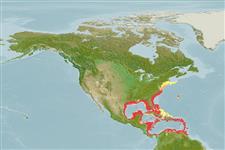>
Eupercaria/misc (Various families in series Eupercaria) >
Lutjanidae (Snappers) > Lutjaninae
Etymology: Lutjanus: Malay, ikan lutjan, name of a fish.
More on author: Linnaeus.
Environment: milieu / climate zone / depth range / distribution range
Ecologia
marinhas; Água doce; estuarina associadas(os) a recifes; anfídromo (Ref. 55); intervalo de profundidade 5 - 180 m (Ref. 55), usually ? - 50 m (Ref. 9626). Subtropical; 42°N - 9°N, 98°W - 59°W (Ref. 55231)
Western Atlantic: Massachusetts south along U.S. coast, Bermuda, the Bahamas, and throughout the Gulf of Mexico and Caribbean Sea. Records from Brazil are based on misidentifications (Ref. 113893). Records from the eastern Atlantic are vagrants (Ref. 10795).
Length at first maturity / Tamanho / Peso / Idade
Maturity: Lm 32.0, range 21 - ? cm
Max length : 89.0 cm TL macho/indeterminado; (Ref. 55); common length : 40.0 cm TL macho/indeterminado; (Ref. 55); peso máx. Publicado: 20.0 kg (Ref. 4883); Idade máx. registada: 21 anos (Ref. 55)
Espinhos dorsais (total): 10; Raios dorsais moles (total): 13-14; Espinhos anais 3; Raios anais moles: 7 - 8. Dorsal profile of head slightly concave, snout long and pointed. Preopercular notch and knob weak. Scale rows on back parallel to lateral line anteriorly, but rising obliquely posteriorly, below soft part of dorsal fin. Young specimens with a dark stripe from snout through the eye to upper opercle and a blue stripe on cheek below eye.
Adults inhabit coastal as well as offshore waters around coral reefs, rocky areas, estuaries, mangrove areas, and sometimes in lower reaches of rivers (especially the young). They are found in fresh water in Florida (Ref. 26938). Often forming large aggregations. Feed mainly at night on small fishes, shrimps, crabs, gastropods, cephalopods and some planktonic items. Easily approached (Ref. 9710). Good food fish (Ref. 9626). Utilized fresh and frozen; eaten pan-fried, broiled, microwaved, and baked (Ref. 9987). Has been reared in captivity (Ref. 35420).
Spawning occurs in summer near the time of the full moon.
Allen, G.R., 1985. FAO Species Catalogue. Vol. 6. Snappers of the world. An annotated and illustrated catalogue of lutjanid species known to date. FAO Fish. Synop. 125(6):208 p. Rome: FAO. (Ref. 55)
Categoria na Lista Vermelha da IUCN (Ref. 130435)
Ameaça para o homem
Reports of ciguatera poisoning (Ref. 31172)
Utilização humana
Pescarias: espécies comerciais; peixe desportivo: sim; Aquário: Espécies comerciais
Ferramentas
Relatórios especiais
Descarregue XML
Fontes da internet
Estimates based on models
Preferred temperature (Ref.
123201): 20 - 27.5, mean 24.8 °C (based on 137 cells).
Phylogenetic diversity index (Ref.
82804): PD
50 = 0.5000 [Uniqueness, from 0.5 = low to 2.0 = high].
Bayesian length-weight: a=0.01479 (0.01302 - 0.01681), b=2.97 (2.95 - 2.99), in cm total length, based on LWR estimates for this species (Ref.
93245).
Nível Trófico (Ref.
69278): 4.2 ±0.3 se; based on diet studies.
Generation time: 6.6 (4.8 - 8.8) years. Estimated as median ln(3)/K based on 10
growth studies.
Resiliência (Ref.
120179): Médio, tempo mínimo de duplicação da população 1,4 - 4,4 anos (K=0.10; tm=2-3; tmax=21).
Prior r = 0.45, 95% CL = 0.30 - 0.67, Based on 1 stock assessment.
Fishing Vulnerability (Ref.
59153): Moderate vulnerability (41 of 100).
Nutrients (Ref.
124155): Calcium = 14.7 [8.0, 24.0] mg/100g; Iron = 0.307 [0.183, 0.560] mg/100g; Protein = 19.5 [18.0, 20.8] %; Omega3 = 0.222 [0.132, 0.370] g/100g; Selenium = 36.3 [18.3, 68.1] μg/100g; VitaminA = 92.6 [15.6, 438.0] μg/100g; Zinc = 0.255 [0.181, 0.390] mg/100g (wet weight);
